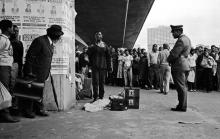A review of Omar Badsha’s ‘Seedtime Retrospective’ at Museum Africa, Johannesburg
Better... read more

IT WAS English art critic John Berger who said: "The true content of a photograph is invisible, for it derives from a play not with form, but with time." His interpretation is of particular relevance to the work of Omar Badsha, a trade unionist, activist, and artist who, since the 1960s, has devoted himself to recording the workers’ struggle, the plight of the disenfranchised, and the longing for a truly nonracial, democratic settlement in SA.
It is time that is ever present in Badsha’s photographs; the moment lifted from history and captured like a vapour in a jewelled casket. They record political meetings, domestic life, small businesses at work, the vastly heterogeneous cultures that make up SA. It is therefore as a record of ordinary life, rather than the grand struggle narrative, that Badsha’s photographs compel the more, because after Berger, it is the visibility of these generally invisible moments, now stilled for all eternity, that restores the humane in the stories Badsha tells.
As Stellenbosch University arts academic Lize van Robbroeck said at a colloquium devoted to the Badsha retrospective, most revealing about the exhibit is the compassion of the photographer; Badsha’s "passionate empathy and interest in working-class people". Van Robbroeck noted Badsha’s ability to capture the "empowering role of religion in the lives of the working class" and, intriguingly, "the eloquence of inanimate objects"
For artist-academic Mario Pissara the Badsha retrospective is "the South African art event of the year" because of its temporal scope. An archival treasure — and Badsha assured those at the colloquium that his holdings contained many more images — the retrospective is clearly an important contribution to the national narrative.
There was, however, heated discussion regarding the institutional arena, the Iziko National Gallery in Cape Town. Badsha charged it with cultural chauvinism because, in his view, it has not satisfactorily honoured SA’s struggle narrative.
NOTWITHSTANDING this thorny debate regarding infrastructural racism and snobbery in institutions across the country, Pissara, on a more optimistic note, celebrated the occasion and Badsha’s ability to create "a dialogue between the political and the aesthetic". Here Pissara paid particular attention to Badsha’s fine art works, largely figure drawings in crayon and pencil inspired by Badsha’s close friend and mentor, artist Dumile Feni. US-based author and academic Neelika Jayawardane on the other hand emphasised the "liminal" in Badsha’s work and intriguingly described his photographs as "a short story form", paying particular attention to the subtle, quiet, and minor dimensions in Badsha’s photographs. Here Jayawardane echoed the celebrated thought of academic and author Njabulo Ndebele who distinguished the "ordinary" from the "spectacular" in SA’s narrative of liberation.
 Tadkeshwar 1965 Image source
Tadkeshwar 1965 Image source
University of the Witwatersrand academic Thembinkosi Goniwe further amplified the discussion by asking those present to reflect beyond the visceral presence of the "ordinary" human being present within the photographs. Goniwe’s point was to challenge the overriding tendency to frame black experience within the confines of abjection and protest. What of the black "imagination", Goniwe asked. He would have wished for a more streamlined, airy exhibition, he said, in which individual photographs had greater room to aerate and fix the viewer’s imagination. GONIWE’S goad would lead to debate regarding Badsha’s decision to self-curate. Far from being an act of narcissism, Badsha, in his defence, recalled the tragic death of Pam Warne, the Iziko National Gallery curator widely regarded as one of the most astute and sensitive choreographers of the art exhibition experience. Fellow photographer George Hallet was on hand to confirm the instrumental role Warne played in the selection process for his own exhibition at the National Gallery. Pissara, always the optimist, stepped in to celebrate Badsha’s efforts and the value of what he termed an "auto retrospective". This poignant coinage then raised the matter of self-affirmation and agency, which was agreed to be an empowering instinct typically suppressed in the chauvinistic bid to balkanise the art world and to generate cartels of influence. Finally it was Badsha’s turn to speak. At the podium, he began to recall his journey as an artist, and the inextricable connection between this journey and his role as an activist. Declaring his age — Badsha is 70 — he began by reminding us of "the racialised situation" he grew up in and his place "outside the system". Raised "in the 1940s within the Congress Communist Party", Badsha said he grew up in "a Communist creche with photos of Nehru and Gandhi on the walls".Badsha moved on to talk of the importance of "creating your own audience as a political act". Emphasising the current dumbed-down, insidious times, a present that he sees as being "in an existential crisis", Badsha reaffirmed the importance of continued activism. With his sights sharply focused on the underprivileged and disempowered, Badsha affirmed the value of the arts as a means to change the world....TO do so, Goniwe added, we would have to champion Badsha’s "interiority, intimacy, pleasure, beauty". By shifting away from the stereotypical "idea of blackness", which is all too easily "normalised", we could pave the way for a more enriching world. This, for Goniwe, Pissara, Jayawardane, and Van Robbroeck is Omar Badsha’s gift. As Van Robbroeck pithily phrased it, the Badsha retrospective "breaks against the imperviousness of history as a pedagogic description".
Vast as the body of work on show is, Badsha assured those at a colloquium, held at the Iziko National Gallery, that there was much more in his archive.
• Seedtime: An Omar Badsha Retrospective is on at the Iziko South African National Gallery, Government Avenue, Company’s Garden, Cape Town until August 2
http://www.bdlive.co.za/life/entertainment/2015/06/12/the-visibility-of-invisible-moments